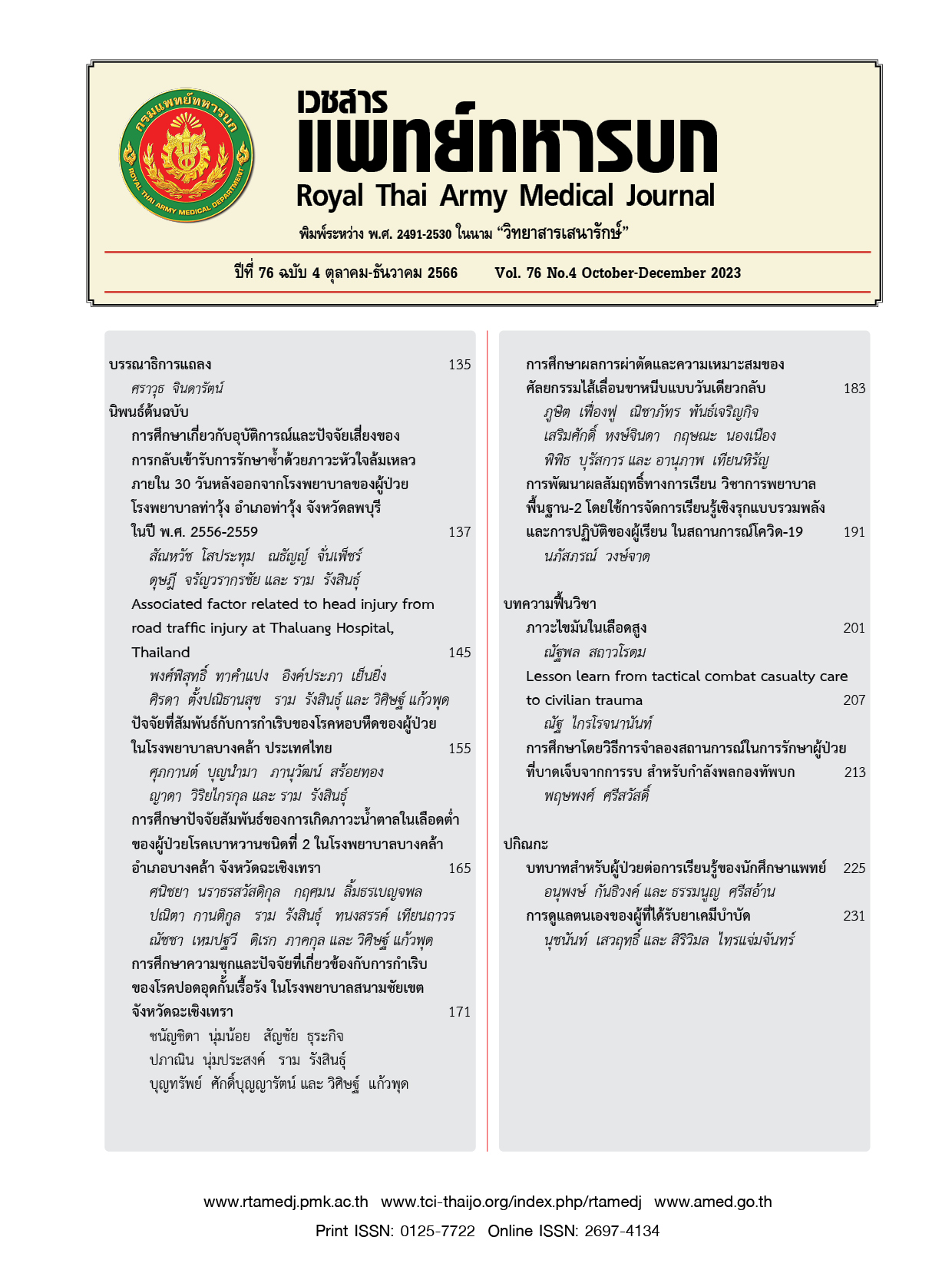การศึกษาผลการผ่าตัดและความเหมาะสมของศัลยกรรมไส้เลื่อนขาหนีบแบบวันเดียวกลับ
Main Article Content
บทคัดย่อ
บทนำ การผ่าตัดรักษาไส้เลื่อนขาหนีบ ด้วยวิธีทางศัลยกรรมแบบวันเดียวกลับ ได้รับความนิยมมากขึ้นตามลำดับในช่วงที่ผ่านมา เนื่องจากมีผลการรักษาที่ไม่แตกต่างจากการผ่าตัดที่ต้องเข้ารับการรักษาแบบผู้ป่วยใน วัตถุประสงค์ เพื่อศึกษาอัตราความสำเร็จ และผลลัพธ์การรักษาของการผ่าตัดไส้เลื่อนขาหนีบแบบวันเดียวกลับด้วยเทคนิค Lichtenstein ด้วยการฉีดยาชาเฉพาะที่ เปรียบเทียบกับวิธีดั้งเดิม วิธีการ ผู้ป่วยที่เข้ารับการรักษาไส้เลื่อนขาหนีบ ช่วงเดือนตุลาคม พ.ศ. 2561 ถึง เมษายน พ.ศ. 2562 ที่อายุมากกว่า 20 ปี, Nyhus class 1-3B จะได้รับการผ่าตัดด้วยเทคนิคแบบวันเดียวกลับหรือแบบปกติ ขึ้นกับความยินยอมของผู้ป่วยและความถนัดของศัลยแพทย์ (purposive sampling) โดยกลุ่มศึกษาจะได้รับการให้ยาแก้ปวดในแบบ preemptive การฉีดยาชาเฉพาะที่ร่วม กับ sedation ขณะผ่าตัด จากนั้นจะได้รับการประเมิน Post anesthetic discharge score (PADS) ก่อนกลับบ้าน ทำการติดตามภาวะแทรกซ้อนและอาการปวดหลังการผ่าตัดในเดือนแรก รวมถึงระยะเวลาที่สามารถดำเนินกิจกรรมต่าง ๆ ได้ตามปกติ ผลการวิจัย ผู้ป่วยที่เข้ารับการผ่าตัดไส้เลื่อนขาหนีบทั้งหมดจำนวน 125 ราย ได้รับการผ่าตัดแบบวันเดียวกลับจำนวน 29 ราย (23.2%) มีอัตราความสำเร็จอยู่ที่ 93.1% การวิเคราะห์ทางสถิติพบว่า กลุ่มศึกษามีอายุน้อยกว่า (50 Vs 62 ปี p = 0.012), ระยะเวลาการผ่าตัดสั้น กว่า (75 Vs 90 นาที, p = 0.005) และ ดำเนินกิจกรรมตามปกติได้เร็วกว่า (5 Vs 7 วัน p < 0.001) โดยที่ภาวะแทรกซ้อนหลังผ่าตัด รวมถึงค่าใช้จ่ายไม่มีความแตกต่างกัน สรุป การผ่าตัดไส้เลื่อนขาหนีบแบบวันเดียวกลับ มีความปลอดภัยและมีผลลัพธ์การรักษาไม่แตกต่างจากการผ่าตัดแบบรับไว้เป็นผู้ป่วยใน
Downloads
Article Details

อนุญาตภายใต้เงื่อนไข Creative Commons Attribution-NonCommercial-NoDerivatives 4.0 International License.
บทความในวารสารนี้อยู่ภายใต้ลิขสิทธิ์ของ กรมแพทย์ทหารบก และเผยแพร่ภายใต้สัญญาอนุญาต Creative Commons Attribution-NonCommercial-NoDerivatives 4.0 International (CC BY-NC-ND 4.0)
ท่านสามารถอ่านและใช้งานเพื่อวัตถุประสงค์ทางการศึกษา และทางวิชาการ เช่น การสอน การวิจัย หรือการอ้างอิง โดยต้องให้เครดิตอย่างเหมาะสมแก่ผู้เขียนและวารสาร
ห้ามใช้หรือแก้ไขบทความโดยไม่ได้รับอนุญาต
ข้อความที่ปรากฏในบทความเป็นความคิดเห็นของผู้เขียนเท่านั้น
ผู้เขียนเป็นผู้รับผิดชอบต่อเนื้อหาและความถูกต้องของบทความของตนอย่างเต็มที่
การนำบทความไปเผยแพร่ซ้ำในรูปแบบสาธารณะอื่นใด ต้องได้รับอนุญาตจากวารสาร
เอกสารอ้างอิง
Primatesta P, Goldacre MJ. Inguinal hernia repair: incidence of elective and emergency surgery, readmission and mortality. Int J Epidemiol. 1996;25(4):835-9.
Kingsnorth A, LeBlanc K. Hernias: inguinal and incisional. Lancet. 2003;362(9395):1561-71.
Burcharth J, Andresen K, Pommergaard HC, Bisgaard T, Rosenberg J. Recurrence patterns of direct and indirect inguinal hernias in a nationwide population in Denmark. Surgery. 2014;155(1):173-7.
Simons MP, Aufenacker T, Bay-Nielsen M, Bouillot JL, Campanelli G, Conze J, et al. European Hernia Society guidelines on the treatment of inguinal hernia in adult patients. Hernia. 2009;13(4):343-403.
HerniaSurge Group. International guidelines for groin hernia management. Hernia. 2018;22(1):1-165
Neumayer L, Giobbie-Hurder A, Jonasson O, Fitzgibbons R Jr, Dunlop D, Gibbs J, et al. Veterans Affairs Cooperative Studies Program 456 Investigators. Open mesh versus laparoscopic mesh repair of inguinal hernia. N Engl J Med. 2004;350(18):1819-27
Department of Medical Services, the Ministry of Public health. Recommendations for the development of the service system ODS (One Day Surgery) 2018. Nonthaburi: the Ministry of Public health; 2018.
Campanelli G. The art of hernia surgery. Switzerland: Springer international publishing AG; 2018
Lichtenstein IL, Shulman AG, Amid PK, Montllor MM. The tension-free hernioplasty. Am J Surg. 1989;157(2):188-93.
Hurst J, Siciliani L. Tackling Excessive Waiting Times for Elective Surgery: A Comparison of Policies in Twelve OECD Countries : Papers DELSA/ELSA/WD/HEA (2003. France: OECD; 2003.


